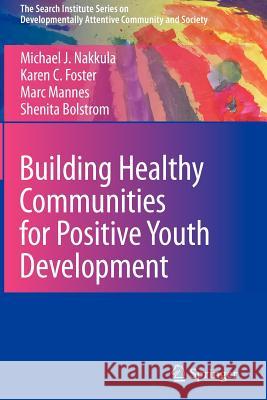Building Healthy Communities for Positive Youth Development » książka
Building Healthy Communities for Positive Youth Development
ISBN-13: 9781441968197 / Angielski / Miękka / 2011 / 189 str.
It is a great pleasure to offer this volume from Michael J. Nakkula, Karen C. Foster, Marc Mannes, and Shenita Bolstrom as the latest in the Search Institute Series on Developmentally Attentive Community and Society. Its importance to the series and this ?eld of inquiry and practice is readily evident in its title, Building Healthy Communities for Positive Youth Development. Since the early 1990s, Search Institute has invited and encouraged communities of all shapes and sizes to use its framework of Developmental Assets and principles of asset building to create strong, vibrant, and welcoming communities for children and youth. We have operated largely at the grassroots level, encouraging innovation and adaptation around a shared vision, rather than proposing a program or model for replication. We seek to learn as much from the communities as they learn from us. This book offers in-depth case studies of what happened in eight diverse c- munities that took up our invitation. In them, we see a wide array of strategies and approaches that, on the surface, seem to have little coherence. But, as Nakkula and colleagues found, underlying each of these distinct efforts was a deep commitment to transforming the social norms of community life to more effectively attend to young people's healthy development throughout the ?rst two decades of life. There have been many ambitious efforts aimed at comprehensive community change on behalf of young people.
The Healthy Communities Healthy Youth (HC HY) project has provided grassroots support for the creation of robust, welcoming environments not only for children and adolescents at risk but for all youth. Building Healthy Communities for Positive Youth Development explains the Developmental Assets framework in depth and demonstrates how eight local initiatives across the country have adapted and implemented it to fit the unique cultures and resources of their neighborhoods and the needs and strengths of their young people. Stakeholders collaborating in the process include parents, educators, politicians, service providers, law enforcement, volunteers, and as active participants instead of merely recipients of services youth themselves.§In this visionary book, the authors provide readers with a flexible, living blueprint for promoting the well-being of children and teenagers. Areas of coverage include:§Core themes of the eight HC HY initiatives.The use of an asset-based common language among participants.Building common ground among the various sectors involved in the initiatives.The varied roles of young people within the initiatives.Research design and methodology; data collection and interpretation.Funding issues and challenges. The mission outlined in Building Healthy Communities for Positive Youth Development fits the interests of a wide range of professionals, including developmental psychologists; child, youth, and family service professionals; clinical child and school psychologists; and allied education and mental health practitioners working with children and adolescents.











